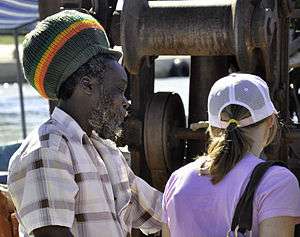Jamaican stereotypes

Jamaica is an island in the Caribbean Sea, located 90 miles south of Cuba, and 100 miles southwest of Haiti. There exist several common stereotypes about Jamaican people.
Marijuana
Marijuana is a preparation of the Cannabis plant intended for use as a psychoactive drug and as medicine. Cannabis is locally known as ganja, and internationally Jamaica, its reggae music, and cannabis consumption play a prominent role in Jamaica's public image.[1]
A common stereotype about Jamaicans is that every Jamaican smokes marijuana. According to the information provided by the World Drug Report, about 10% of Jamaicans smoke marijuana. Though many people might think that marijuana is legal, smoking in public results in being arrested by authorities. Many tourists had been arrested because of the thought that marijuana is legal.
Men
The general perception of Jamaican men is that they are womanizers.[2]
Rastafari
While Rastafari is a common religion among black Jamaicans that look up to the past Ethiopian emperor Haile Selassie, only 3% of the population practices this religion
Family size
The population growth rate in Jamaica is at 0.7%, and it is considered to be an underpopulated country. On average, each woman gives birth to two children.[3]
Economy
Jamaica is in a lot of debt; public debt has increased to 140% of the GDP, due to deficits and excessive debt service and borrowing. However, there have been improvements in procedures regarding to starting businesses, foreign investment is more available, and property rights are more secured.[4]
Skin color
Another stereotype is that all Jamaicans are black, but this is not the case.[5]
Stereotypes about black people may affect Jamaicans of color, because some white people do not distinguish between different ethnicities of non-whites.[6]
See also
References
- ↑ Michael Veal (15 August 2013). Dub: Soundscapes and Shattered Songs in Jamaican Reggae. Wesleyan University Press. pp. 33–. ISBN 978-0-8195-7442-8.
- ↑ Tinuoye, Kunbi (November 1, 2013). "'My Crazy New Jamaican Life' doc under fire for reinforcing stereotypes". theGrio. Retrieved 13 December 2013.
- ↑ "Jamaica Total fertility rate - Demographics". IndexMundi. 2013. Retrieved 13 December 2013.
- ↑ "Jamaica Economy". The Heritage Foundation. Retrieved 13 December 2013.
- ↑ Archambeau, Gerald A. (2008). A Struggle to Walk with Dignity: The True Story of a Jamaican-born Canadian. Dundurn. ISBN 9780978498207. Retrieved 13 December 2013.
- ↑ Foner, Nancy (1978-01-01). Jamaica Farewell: Jamaican Migrants in London. University of California Press. p. 42. ISBN 9780520035447.
Further reading
- Bailey, Margaret (February 1, 2013). "The Top 20 Jamaican Stereotypes: Truth or Fiction? (Jamaica)". Retrieved 13 December 2013.
- Batson-Savage, Tanya (June 2010). "Through the Eyes of Hollywood: Reading Representations of Jamaicans in American Cinema" (PDF). Small Axe. 14 (2): 42–55.
- Cuthbert, Marlene (April–July 1979). "News Selection and News Values: Jamaica in the Foreign Press". Caribbean Studies. 19: 93–109. JSTOR 25612861.
- Layng, Anthony (April 1975). "Stereotypes and Ethnic Relationships in the Caribbean". Caribbean Studies. 15 (1): 130–134. JSTOR 25612680.